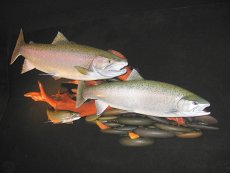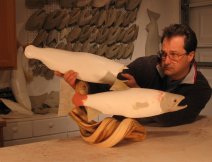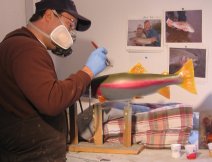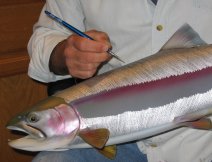Luke’s process to create each fish sculpture starts with carefully sculpting the form to match the physical attributes of the fish.
As the scent of rain travels on a warm summer breeze, a feeling of anticipation and excitement starts to gather inside Luke Filmer as he wades out into the water and begins the patient ritual of casting his fly line. With each graceful cast he releases more line until the line takes perfect flight. As he watches his fly dance across the water he contemplates on how much he enjoys the patient ritual of tying the perfect fly to tempt a hungry trout out of its hiding place. His thoughts quickly fade as the fly drifts downstream and is suddenly engulfed by a large trout. The line tightens and his heart starts to pound with no awareness of which action took hold first. He instinctively lifts his rod to set the hook, a ritual he has performed a thousand times before. For a brief second he feels the excitement work toward its peak when suddenly and without warning the trout rejects the fly and retreats back to the dark depths. As Luke slowly retrieves his line, carefully wrapping each loop around the reel, memories surface of fish he has caught in his lifetime and of those that "got-away". He chuckles to himself how ironic it is that the memories of the fish that got away are the memories that haunt him most.
Several weeks later after returning from one of his fishing trips Luke found himself daydreaming again about the trout that eluded him that day. He wanted to capture the memory of that fish and started calling taxidermists in his area. During one of these conversations he learned of a process to replicate the fish with a fiberglass form. "I was amazed at the notion that they could paint a replica of my fish using my photograph and measurements," he explains. As he learned more about the process an idea started to take root that perhaps this is something he would enjoy doing in his spare time. "I've always been creative and loved to sketch and paint when I was young. Because I grew up in places like Yellowstone, Yosemite and the Rocky Mountains, I spent hours sketching wildlife and my surroundings. It seemed like a natural fit for me to combine my enthusiasm for fishing and my love of art," he explains. As he learned more about the process, it became clear to him that in order to excel in the fiberglass replica business he would learn to transform a lifeless fiberglass form into a life-like piece of art, keeping in mind that each art piece should be designed to tell a story.
Luke's process to create each fish sculpture starts with carefully sculpting the form to match the physical attributes of the fish. Care is taken to ensure the length and measurements are exact and each unique characteristic of the fish is captured. If the fish has an unusual shaped head or perhaps the mouth is blunt or long, Luke captures those unique features when building the form. "My clients appreciate the attention to detail I give their art piece," adds Filmer. Once the form meets with his approval, he moves onto the next phase - placement. He describes the time and patience it takes to design the perfect placement of the fish whether it's nestled within a habitat background, or featured over a custom base. He will not move onto the painting stage until he is satisfied with the vision he has for the piece. Painting these fiberglass forms has become second nature to Luke. He uses a combination of air brushing and hand painting to capture the essence of each fish. "I recreate colors by mixing my own paints, incorporating new varieties, overlapping and layering colors on the form, and take the time to ensure I match the exact color of the fish," notes Luke. He goes on to add, "Once the colors are perfect, I match the spot constellations that make each fish unique, just like your fingerprints." The final step is to paint each scale with a tiny brush. "This step takes the most time but is the commitment I make so each fish replica I create is perfect," Filmer says proudly. As a result of Luke's commitment to each art piece he has created close to 600 original fish sculptures for clients since 1998.
Creating these fiberglass fish replicas for clients has allowed Luke to support another one of his passions, "catch & release" fishing. He has always practiced this fishing method and takes satisfaction in knowing his art supports this fishing approach. Because of limited resources several lodges and rivers are moving toward catch and release fishing only. Many guides and fishing lodges encourage anglers to take a photo of their catch and let the fish go. "Taking a photo of the fish allows anglers to have a custom replica made when they are ready. I have clients or guides call Blackwater right after they caught the fish, or sometimes years later when they are ready to preserve their memory with a fiberglass replica," explains Filmer.
Currently on the workbench is a double Alaskan rainbow trout display commissioned by a client that requested an art piece that commemorates many of his Alaskan fishing adventures. "Listening to the client's fishing stories is one of the most important aspects of what I do. It allows me to glean information that I incorporate into the final art piece," explains Filmer. Often referred to as leopard trout, these unique creatures exhibit a spot pattern true to their namesake. Besides capturing their spot pattern, the client asked Luke to capture the bright crimson stripe that extends across their flanks and also the splash of red pronounced within their cheeks. Having also fished in Alaska, Luke had first-hand knowledge of what these fish look like up close and how they behave in the wild. He noted that often these fish will school together and inevitably seek a mate to partner with. Luke suggested a pedestal style display featuring a male and female rainbow pair swimming together over a streambed base. The client liked this design because it would allow him to display the art sculpture on a table located in the center of his conference room. Once they agreed on the concept it was time to go to work. "Choosing the right fiberglass form that shows the interaction of the fish is critical when designing interpretive displays. I bring the piece to life because I take into account that they are swimming together, in a current, moving in tandem with each other, and anticipating each other's movements," explains Filmer. He goes on to add that after he has chosen the right form he meticulously assembles and sculpts each model taking care to position their fins in a way that expresses intent or movement of the fish. He then positions their eyes to indicate a mutual awareness of each other's presence. Once the forms are crafted the next step is to design a base or habitat background for the fish. For this particular project Luke wastes no time in selecting some unique mahogany he recently purchased. "Working with wood has always been a hobby of mine and keeping my studio supplied with unusual woods is a fun field trip for me. For this particular base I am using a unique piece of twisted juniper. This will allow me to create the height I need to incorporate the fish interaction I am seeking," explains Luke. Once the base is designed he moves onto the next critical step of placing the fish over the base. With clear determination and a talent for placement, he adapts the medium of fiberglass and wood together to create what has clearly become his signature background or base styles. "I have already seen what this will look like in my minds-eye and now I just need to assemble the vision," explains Filmer. The final step in Luke's process is to add color. Creating a painting style that is his own, Luke moves his airbrush in a manner that demonstrates that he has perfected another patient ritual. Blending together the right colors and shimmers he captures the essence of each fish. Once the color matches the photograph or his vision he moves to the final step Luke calls "scale-tipping". Mastering this final patient ritual is what has set his art apart from other's in his industry. "I hand-paint each scale by hand because this is part of my dedication to make each piece perfect. It's not taxidermy, it's in fact art."
Luke's appreciation of fish and the joy fishing brings him is captured in every fish replica sculpture he creates. Through a lifetime of fishing and years of researching his favorite subjects, he has perfected his craft to become one of the best wildlife artist in the country. "There is a peacefulness and serenity in what I do and I work hard to make each art piece more beautiful than the one before," notes Luke. As he makes his way to his studio, visions of his next art piece start to form. Anticipation and excitement builds, tempered by an inner knowledge that through years of mastering his patient rituals, he will preserve another angler's memory of their perfect day on the water.

















